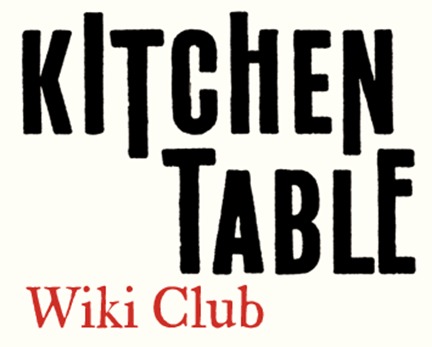
Wiki Club Gathering November 2, 2021: Roberta’s Sum-Up on Resources and Citations
This month we looked at resources and citations. Wikipedia depends on reliable sources. (WP::RS.) Ideally, each factual assertion in every article should be backed up. This is where you come in. You probably have access to a library of food-related information: perhaps books you have collected yourself, or a university library, including digital collections. If so, you are in an excellent position to add citations to articles that are lacking them (which is most of the food & drink articles). As I said at our October session, I recommend editing existing articles before trying to create your own new ones. Your access to sources can be of material benefit to Wikipedia.
Bear in mind the nature of an encyclopedia as a tertiary source. It synthesises information mostly from secondary sources, although sometimes from primary and other tertiary sources as well. Your grandmother’s handwritten recipe book is a primary source, as are your anthropological notes made while visiting kitchens in far-flung places. Using them counts as original research, which is forbidden. ( WP:OR)
Whatever sources you cite need to be findable by other Wikipedia editors too, in principle. Many prefer digital sources, but printed books are fine. The English-language Wikipedia does not require the use of English-language sources, and the benefits of translation will be covered in our December gathering. Material does not need to be free of cost, but if you have access behind a paywall, so much the better.
The content guidelines within the encyclopedia can be reached via the shortcuts WP:RS, WP:OR and so on, which you can type into the Wikipedia search box. If at any time you can’t remember the shortcut or the terminology that Wikipedia prefers (e.g. the precise phrase “reliable sources”), or you can’t find the guidance you need within Wikipedia, use a general search engine instead, and that should direct you to the correct page or portal.
In October I introduced you to WikiProject: Food and drink. It includes a page of useful sources (mostly books), which name-checks the Symposium and many of our stalwarts. A Wikipedia editor involved with creating that page showed up to our November gathering, which is great, as the word begins to spread. Invite your friends to join in, as we improve Wikipedia’s food coverage.
I spent some time demonstrating how I add citations to an existing article. From comments in the chat, this appeared popular, so I’ll incorporate more live editing in future sessions too. Here are the resources I recommend to get started:
- Beginner Training – Adding Citations (Art + Feminism video)
- Help:Referencing for beginners (unofficial brief how-to guide)
The article that you watched me editing was Norwegian cuisine. You can check its history to see what I did. I added a sentence (before the session), and then returned to that sentence (during the session) to add a reference to the book from which I obtained that information. I also added a small section on people, and named two who already have biographical articles, adding appropriate links.
When you make your edits, you have the choice between Visual Editor (similar to a word processor) and wiki mark-up (like HTML) for “mainspace”, i.e. the articles. Either of these allows you to enter a book’s ISBN, and all the bibliographic information is auto-generated at the touch of a button. (Unfortunately, talkpages – the places where Wikipedians communicate and collaborate – don’t allow Visual Editor. It is a draw-back.)
- Wikipedia:VisualEditor – Wikipedia (portal)
Things to do
- Look at the list of food & drink articles that need citations. Consider the reliable sources to which you have access. Choose an article and improve it by adding a citation to a statement which needs it. Use the “cite” button and practise entering the minimum of information (e.g. the ISBN), allowing the software to auto-generate the rest.
- Leave an edit summary (e.g. “added a citation”). Review your changes: does it appear the way you want it to? Publish changes.
- Keep editing! Try to make improvements to a few different articles. If you have a query about the way forward with a particular article, explain your position on its talkpage, and if no one responds within a day or two, reformulate your question for the Teahouse.
- Remember your successes; we’ll be asking for examples to share at our next session.
And a re-cap of the basics:
If you are a complete newbie, start with the hour-long video I made for the 2020 Symposium. Some people then like to dive straight in; others prefer to learn more first. Here is a list of short how-to videos; most are 3-5 minutes long.
Beginner Training (from Art + Feminism, a group created to combat systemic inequalities )
Userpages and the Sandbox
Basic Rules of Wikipedia editing
Adding Citations
Anatomy of a Page
Creating New Articles
Wikipedia Training Video Part 1 – followed by parts 2 & 3
Produced by the Wikimedia Foundation
The Wikipedia Adventure – long but light-hearted
Various sources
Editing Basics (Visual Editor) – this is the option that looks like a regular word processor
How to Create a Wikipedia Account – Tutorial
How to Edit a Wikipedia Article
These are all videos, of course. If you prefer your training in writing, use the titles above to search for an equivalent written how-to.
